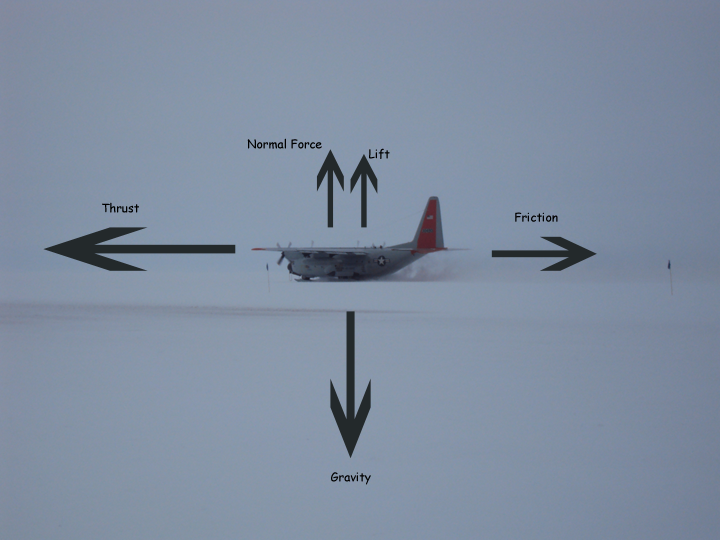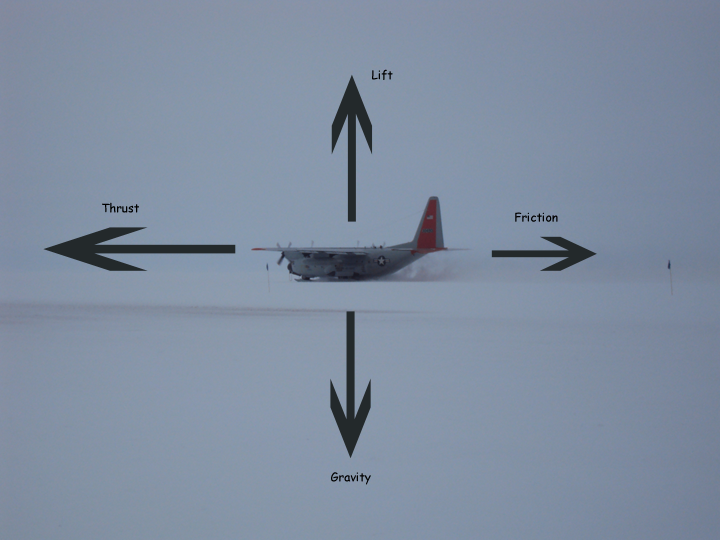
|
From
touch down to take off the planes run continuously, cold temperatures
and lack of facilities necessitate this. However on a C-130, as with
most large propeller driven aircraft, the propellers can be twisted in
place to adjust their pitch.
While just sitting on the runway the propellers are "feathered" into a
neutral position where they produce almost no thrust. When the plane is
in this state the force backward from static friction exceeds the
thrust of the propeller, and no movement occurs. Since the plane isn't
moving, there is no lift, and it is supported entirely by the ground,
so the normal force is then equal to the force from gravity. The plane
is in static equilibrium with respect to the ground. It's not so visible here, but the propellers do generate some thrust even when fully feathered. Empirically we know this because of the air flow behind the plane. Standing rearward of the propeller feels like standing outside in a blizzard, even though the plane is not moving. Since the propellers are pushing backwards on the air, we can be assured that the air is pushing forward on them. In this case its just not enough to overcome the force backward from friction. In order to actually take off, the pilots throttle the engines up and rotate the propellers into position. It takes the engines a few seconds to respond to the increase in throttle, then they spin at a mostly constant speed. In this configuration, the plane is accelerating horizontally, the thrust from the propellers exceeds the static force of friction, then continues working against the kinetic force of friction moving the plane forward. The force of gravity on the plane is constant throughout the take off, and remains in contact with the ground until the very end of the take-off roll. During this time the lift from the wings increases until it eventually equals the force of gravity at the very end of the take off roll. After this point, the pilots pull back on the stick to increase the attitude of the plane, and it lifts off the ski-way into flight. As a result of the increasing lift, the normal force from the ground steadily decreases, from 100% of the force of gravity at the very beginning, to 0 at the very end.  This picture is taken at the very beginning of the take off, so the normal force will still account for almost all of the upwards force. The thrust is now larger than the friction force and the plane accelerates forward. As the plane makes its way down the skiway the lift will begin to account for more and more of the total upwards force. The final state of the plane during take off is at that final instant before it lifts off from the ground. At this point the plane is still accelerating, but only in the horizontal direction. Take off speed has just been reached, and the entire weight of the plane is being supported by the lift from the wings. This is the point at which flight can begin, all it takes is a touch more speed or a slight upwards attitude adjustment to begin flight.  At the final moment the forces would look something like this. The lift is equal to the gravity, and any further increase in speed or pitching up the plane will cause it to lift off and fly. At this point the normal force on the plane is zero, so the friction force between the plane and ground will also be zero. However there is still friction between the air and the plane, and until they actually do lift off the ground the skis will be plowing through some amount of loose surface snow. Next |